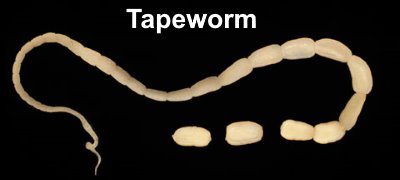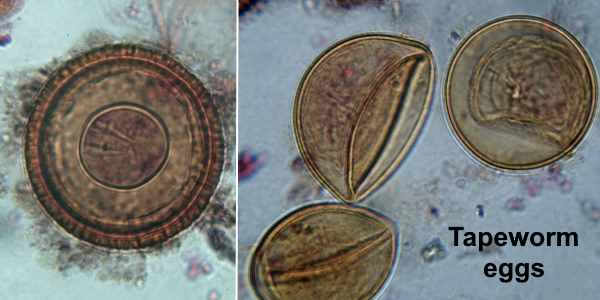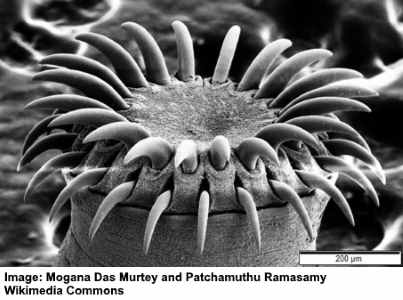Tapeworms in Humans: Symptoms and Treatments (Pictures Included)
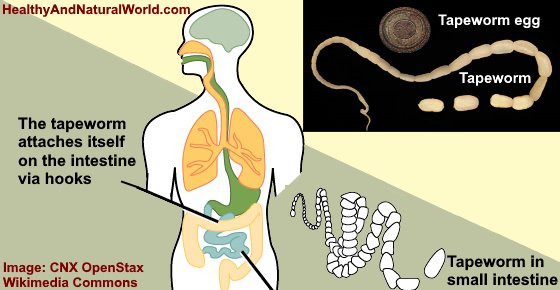
Tapeworm (also called cestode) is a type of parasite infecting humans and animals. Tapeworms are also referred to as flatworms and they live in the digestive and intestinal tract of humans and animals. The symptoms of a tapeworm infection in humans can include abdominal pain, diarrhea, fatigue or weight loss. In some cases, tapeworm infection (medical name taeniasis) can cause other symptoms such as headaches and itchy red rash. Sometimes, stool from a human affected by these parasitic worms will contain eggs and segments of tapeworm.
The most common reason for humans getting tapeworms is ingesting contaminated food or water that has tapeworm eggs. In many cases, signs of a tapeworm infection occur months or even years after the tapeworm entered the human body.
In this article, I will look at what tapeworms are and what symptoms can help you know if you have a tapeworm. You will also find some scientifically-proven home remedies to get rid of tapeworms in humans.
What is a Tapeworm?
Tapeworms are a type of parasite that can live in the human’s body and may or may not cause a wide range of symptoms.
Researchers from the Centers for Disease Control and Prevention report that there are a number of species of tapeworm known to infect humans. The most common types of tapeworms that can cause parasitic infections in humans are:1, 2
- Taenia saginata – tapeworms from eating contaminated beef.
- Taenia solium and taenia asiatica – tapeworms found in pork.
- Diphyllobothrium latum – tapeworms in humans from eating undercooked or raw fish.
Lifecycle of a tapeworm in humans
Getting rid of tapeworm parasites in humans can be a challenge because of their lifecycle. Dr. Richard D. Pearson from the University of Virginia School of Medicine says that the lifecycle of a tapeworm is as follows:3
- Tapeworm larvae or eggs enter the body through contaminated food.
- The tapeworm grows in the intestines and attaches itself to the intestinal wall.
- The tapeworm grows into a segmented body. Sometimes the segments break off and you can see tapeworm segments in stool.
- The tapeworm also produces more eggs that end up in human stool.
- Tapeworm infections in humans can happen when spheres from the parasite enter the bloodstream. This can cause cysts in the liver, brain, or other organs.
What Does a Tapeworm Look Like?
When you see a picture of a tapeworm, you will notice that the parasite looks like a long, segmented worm.
Doctors from the National Health Services say that tapeworms can resemble a measuring tape because they are flat and look like a ribbon. When you have a tapeworm infection, your poop may also show signs of a tapeworm in it. Parts of tapeworm in stool can look like grains of white or yellow rice that wriggle around.4
Tapeworms can also grow very long. Some tapeworms may be as short as 2 inches (50 mm); however, many tapeworms from infected beef or pork can grow as long as 15 to 30 feet (4 to 8 m). Doctors from the Mayo Clinic report that some tapeworms grow to 80 feet (25 m)!5
Tapeworm Pictures
Pictures of tapeworms show that they look like flat, ribbon-like worms that have a head, neck, and segmented body.
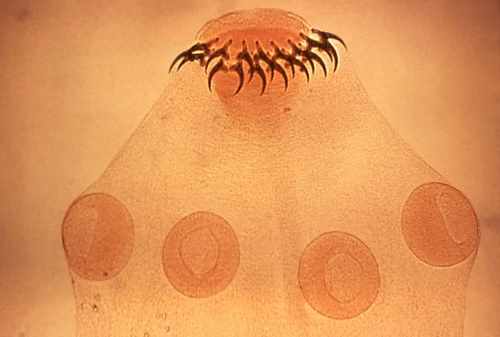
Taenia solium tapeworm head (scolex) with its four suckers, and two rows of hooks to attach itself to the intestinal wall.
How Do You Get a Tapeworm?
Dr. Richard D. Pearson explains how tapeworms end up infecting humans. People get the an intestinal tapeworm infection by eating contaminated raw or undercooked meat or certain types of freshwater fish.3
Another way that tapeworms can cause parasitic infections in humans is through human feces. If an infected person doesn’t wash their hands after using the bathroom or changing diapers, they can transfer parasite eggs to the mouth or food. Adults and children can then get a tapeworm infection if they eat the contaminated food.
The journal Canadian Family Physician reported that eating sushi or raw marinated fish that has been caught in contaminated waters could be another way that humans get tapeworms.6
Tapeworm Symptoms in Humans
The symptoms of a tapeworm in humans are not always apparent.
The journal Clinical Microbiology Reviews reports that some people with a tapeworm lodged in their intestine might never show any symptoms at all. Other people may only have occasional mild signs of an intestinal tapeworm infection and attribute them to something else.7
However, you may have a tapeworm infection if you frequently suffer from the symptoms bellow:
Abdominal pain
A common sign of having parasitic worms such as tapeworms is abdominal pain.
The American Journal of Case Reports found that abdominal pain is common in cases of human tapeworm infections. Depending on the size of the tapeworm in the intestines, the abdominal pain can become chronic and cause other signs of digestive upset.8
Chronic abdominal pain is a type of pain you should never ignore.
Diarrhea
If you have an intestinal tapeworm infection, you may have bouts of diarrhea which may have pale color.
According to the Annals of Medicine and Surgery, intermittent diarrhea along with abdominal pain can be symptomatic of a tapeworm infection. In many cases, the nasty parasite can cause stomach pain after eating and also be a reason for bloody diarrhea.9
Ginger is a great digestion remedy that can help soothe abdominal upset and ease symptoms of diarrhea. Please read my article for some natural remedies for getting rid of diarrhea after eating.
Fatigue
Researchers from the Iowa State University report that foodborne parasitic infections, such as tapeworms, can be a source of constant fatigue. In some cases, taeniasis (tapeworm infection) with many parasites may cause a chronic feeling of tiredness along with muscle pain and cramps.10
Of course, there could be other reasons why you feel tired all the time.
Weakness
As well as battling with feelings of tiredness, having a tapeworm in your gut can leave you feeling weak and exhausted.
According to Dr. Sowmya Nanjappa on Medscape, taenia infections caused by an intestinal tapeworm can cause weakness. The weakness can result from the parasite infection causing cysts that affect the central nervous system. This can also cause dizziness, headaches, and being overly excited all the time.11
Itchy red rash
Having a parasitic tapeworm in your digestive system from eating undercooked pork or raw beef could be a reason for having an itchy red rash.
Dermatologists report that itching, red rashes on the body, and hives are some signs of a tapeworm infection.12
If you think your body is itching for no reason at all, it could be a sign of having a tapeworm, especially if you also have abdominal cramping and frequent diarrhea. Please note that although not caused by a worm, ringworm can also cause an itchy red rash due to a fungal skin infection.
Anal itching
Parasitic tapeworm infections can cause you to have a chronic itch in and around your anal opening.
The Korean Journal of Parasitology says that one of the main symptoms of gastrointestinal parasites in stool is anal itching. The tapeworm symptom of anal pruritus is caused by an allergic response to tapeworm segments as they got passed in a bowel movement.13
Other reasons for an itchy rear end include hemorrhoids, an anal fissure, yeast infection, or eczema.
Headaches
Some tapeworm infections can result in more serious symptoms than just abdominal discomfort. Tapeworms from consuming infected pork can cause cysts to form in the brain which results in headaches.
The journal Baylor University Medical Center Proceedings reported on a man who complained of frequent headaches and seizures. The cysts occur when larvae from the tapeworm get into the bloodstream and cause cysts in the brain and other organs.
Usually, headaches are nothing to worry about. However, if you start to get frequent headaches with other symptoms like balance problems and seizures, you should see your doctor for the head pain.
Unexplained weight loss
Having a tapeworm attached to your intestinal wall could be a reason for losing weight for no apparent reason.
Tapeworms feed by absorbing nutrients through their skin. Dr. Richard D. Pearson (quoted earlier) says that this can result in weight loss. The loss in weight could be due to nutritional deficiencies, a loss of appetite, or diarrhea – all symptomatic of a tapeworm intestinal infection.3
However, not all tapeworms lead to a dramatic loss in weight. The journal Surgery for Obesity and Related Diseases reported on a case of an obese person who had a tapeworm that was tens of centimeters long. The intestinal parasite was only discovered during bariatric surgery.14
Vitamin B12 deficiency
Because of the way tapeworms feed in your intestines, you may show signs of anemia or vitamin B12 deficiency because of the parasitic tapeworm infection.
The journal Clinical Microbiology Reviews reported that some tapeworms from ingesting contaminated fish can cause a chronic lack of vitamin B12 in the blood. This is usually a sign of a large infestation of parasites that absorb about 80% of the body’s B12 supplies. A vitamin B12 deficiency that is connected to a tapeworm infection can also affect the central nervous system.7
Some other warning signs of a vitamin B12 deficiency include fatigue, digestive problems, muscle weakness, and difficulty sleeping.
Noticing bits of tapeworm in human stool
A classic tell-tale symptom a tapeworm infection in humans is small segments of the parasite in your poop.
Researchers in the Canadian Family Physician reported that tapeworm infections cause eggs and tapeworm segments in poop. Some reports say that tapeworms in human stool can appear as long as 2 years or more after being infected. Because of the lifecycle of tapeworms, it is uncommon to find adult tapeworms in stool.15
Tapeworm Symptoms in Children
Tapeworms are common in children because children tend to be less careful about hygiene and can easily transfer tapeworms eggs to the mouth via unclean hands.
Many of the symptoms of tapeworms that affect adults also affect children. However, reports from doctors specializing in parasitic diseases say that children often exhibit different tapeworm symptoms. Some of the signs of an intestinal tapeworm in children include:11
- Colicky abdominal pain
- Changes to appetite – this could be increased appetite or a reluctance to eat food
- Nausea
- Complications of a tapeworm infection that affect the central nervous system
Tapeworm in Humans – Complications
As already mentioned in the article, tapeworms may not cause any symptoms at all in many adults or children. However, tapeworms also have the potential to cause serious complications. Two complications of human tapeworms are a blockage in the biliary system and cysticercosis.
Digestive blockages and appendicitis
Doctors from the Mayo Clinic report that a serious complication of a person having a tapeworm is that it can block bile ducts. If these parasitic worms grow large enough, they can also block your appendix and cause appendicitis.5
Cysticercosis
Doctors from the Centers for Disease Control and Prevention say that cysticercosis is a tissue infection caused by parasites. Larvae from the parasitic worms in your gut can get into the bloodstream and cause cysts to form in other organs. The cysts can grow large enough to restrict organ function.16
How to Get Rid of Tapeworms in Humans
No person likes the thought of parasites that grow 16 or 20 feet in length clinging to their intestines. What can you do to get rid of tapeworms naturally? Here are some tapeworm treatments that are backed up by scientific research.
Food grade diatomaceous earth to get rid of parasitic worms in humans
Food grade diatomaceous earth (DE) is a natural parasite killer that is non-toxic to humans.
According to the National Pesticide Information Center, diatomaceous earth that is classed as “food grade” is safe enough for human consumption.17 A study published in the journal Poultry Science reported that when DE was added to hen feed, the number of intestinal parasites were greatly reduced.18
How to use DE for getting rid of human parasites:
- Mix 1-2 tablespoons food grade diatomaceous earth in a large glass of water. At the start, you may want to use less DE (1 teaspoon) in the solution and gradually build it up to allow your body to get used to the mixture.
- Consume one glass of the parasite treatment daily on an empty stomach (at least one hour before or two hours after eating).
- Continue using the home remedy for parasites for 2 weeks.
- You may stop using the DE drink and take a week off and then begin the cycle again (some people have found different strategies that work for them and take it daily for a few weeks).
- Resume consuming the DE anti-parasite remedy for another 2 weeks to help rid your body of tapeworms.
Garlic to treat intestinal worms
You can use garlic as a powerful medicine to kill off tapeworms and other intestinal parasites in your body.
According to research published in the journal Parasitology Research, garlic contains compounds that have antiparasitic properties. Scientists discovered that consuming a dose of garlic daily helped to kill off foodborne parasites.19
How to use garlic for treating signs of tapeworms:
- Crush 2 garlic cloves and let them stand for 10 minutes. This helps activate allicin which contains the anti-tapeworm properties.
- Mix the crushed garlic with two tablespoons of plain raw yogurt.
- Consume the garlic parasite remedy first thing in the morning.
- Repeat the remedy daily for up to 2 weeks until symptoms of your tapeworm infection have gone.
Pumpkin seeds
Another natural parasite remedy that can help to kill off tapeworms in your intestines is pumpkin seeds.
According to research published in the journal Acta Tropica, a daily dose of pumpkin seeds helped to reduce symptoms of tapeworms. Scientists discovered that just taking pumpkin seeds daily was enough to lower parasite load in 75% of the study’s participants.19
You can help eliminate tapeworms from your gut by consuming a few tablespoons of pumpkin seeds daily.
Papaya seeds
Papaya seeds contain anti parasitic (anthelmintic) compounds and may act as a natural anthelmintic remedy.
According to The Journal of Medicinal Food, it was found that consuming papaya seeds helped eliminate between 71% and 100% of all signs of parasites in stool. Researchers concluded that papaya seeds can be a cheap, natural strategy against intestinal parasites without any side effects.24
To create a parasite cleanse diet with papaya seeds, grind 5 or 6 papaya seeds and drink daily in a glass of water, milk or smoothie to eliminate parasites. Continue taking the papaya remedy for 2-3 weeks to ensure that all traces of intestinal parasites are gone for good.
If you cannot get fresh papaya, you can find organic papaya seed powder in health stores or online. Use one teaspoon of papaya seed powder in a glass of water and drink daily.
Onion
According to a study published in the journal Parasitology Research, onion extract was effective in reducing the number of parasites in animals. In the study, ground onion was added to coconut flakes and food. The result was that all signs of parasites were nearly eliminated in stool samples.25
To use onion as part of a parasite cleanse, squeeze the juice from an onion so that you have about 2 teaspoons. Mix the onion juice with some raw plain yogurt and consume daily. Continue the parasite cleanse with onions for 2-3 weeks to be sure that you completely get rid of parasites and intestinal worms.
Parasite Cleanse Supplements
Clove oil. According to the Journal of Medical and Microbiology, clove oil helps to destroy parasites and intestinal worms naturally.20
Oregano oil. One study found that you can use oregano oil as an anti-parasite supplement to help rid your body of tapeworms.21
Wormwood extracts. The journal Trends in Pharmacological Sciences reported that wormwood extracts are now being used as a natural treatment for malaria. However, scientists have discovered that wormwood is also effective in treating many internal parasitic infections in humans.22
Black Walnut. Tinctures and extracts of black walnut are traditionally used to kill intestinal parasites according to the Pharmaceutical Society of Australia.23 According to Drugs.com, black walnut has many traditional uses, however, there are no human trials to support these effects.28
Olive leaf extract. It was found that olive leaf extract has anti-parasitic benefits for goats infected with intestinal parasites.29 You can take olive leaf extract supplement or make your own olive leaf tea.
How to Prevent Tapeworms in Humans
Proper hygiene and good food preparation methods are the best ways to prevent tapeworms infecting the human intestinal system. Dr. Nick Imm on Patient.info recommends the following tapeworm prevention methods:
- Cook meat thoroughly. Whole cuts of beef and pork should be cooked to at least 145° F (63° C) and ground meat at 160° F (71° C).
- Freeze fish for at least 24 hours or cook fish thoroughly.
- Don’t eat raw meat products or raw fish.
- Always wash your hands after using the bathroom.21
FAQ About Tapeworm Infections in Humans
Here are answers to some common questions that people ask about tapeworm infections in humans.
Can humans get tapeworms from a dog?
Yes, but it is very rare that you can get tapeworms from dogs. Researchers from the Centers for Disease Control and Prevention say that larval tapeworms that affect dogs could, in theory, infect humans. However, for this to happen, a person would have to ingest a flea infected with a tapeworm larvae. Most reported cases involve children.22
Can humans get tapeworms from a cat?
The risk is extremely small and most reported cases involve children. You would have to swallow an infected flea from a cat that has tapeworms.
Are tapeworms contagious?
Yes, tapeworm infections can be highly contagious. Doctors from the National Health Service report that you can catch tapeworms from another person. A person who has tapeworms will pass tapeworm eggs in their poop. This can infect food, clothing, or surfaces if proper hygiene practices aren’t followed.4
How long do tapeworms live for?
Doctors from the Mayo Clinic say that tapeworms can live for up to 30 years in the human intestines.5
When to See a Doctor
Doctors advise that if you have any symptoms of having a tapeworm, you should seek medical attention.5
Related articles:
- Man Infested With Hundreds of Worms After Eating This Common Food
- How to Get Rid of Worms in Humans (Including Parasite Cleanse Diet)
- How to Tell If You Have Intestinal Parasites and What to Do About That
Medical Sources

